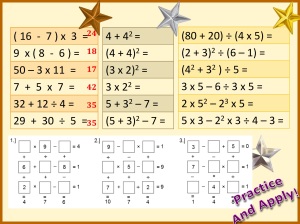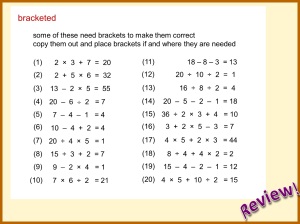Two Lessons, Two Year Groups: Translation and BIDMAS
The final #MTBoS blogging challenge is about a lesson taught this week. I couldn’t decide between two of them, so thought I’d write about both, being two quite contrasting groups. Firstly, year 10 (14-15 year olds), who find maths quite challenging and haven’t had much success in their achievement over the years, but are working extremely hard and hopefully becoming more confident, learning about translation and then year 7 (11-12 year olds) learning order of operations, a group full of high achieving pupils.

Both lessons started in exactly the same way, with the brilliant Numeracy Ninjas by @maths_master William Emeny (greatmathsteachingideas). I do some sort mental arithmetic or skills practice at the start of every lesson, as not only does it set the routine for the pupils, it settles them into thinking right from the start of the lesson, and ensures their numeracy skills are regularly practised to support with the fluency when tackling tougher topics. For the year 10s, they are focussing on the first two sections, mental numeracy and timestables, whereas year 7 whizz through these two sections and focus on the key skills section. We then pick out a question that pupils struggled with to review, before launcing into the topic for the lesson.
Year 10 Translation
I knew when planning this lesson that the year 10 group studied translation last year, so they should know what it is. However, they wouldn’t have used vectors before, so this was the focus of the lesson.

We started with a quick reminder of translation, then headed straight into what a vector was. An explanation from me, some note taking and a few vectors for the pupils to think about what they mean.
 We then spent a chunk of time identifying the vectors that would move the points, and then shapes.
We then spent a chunk of time identifying the vectors that would move the points, and then shapes.

This was whole class questioning, and they weren’t allowed to use the words left, right, up or down, just the two numbers in the vector. I, of course, threw in a question where there was only movement in one direction, and pupils discussed how they would give the vector for that. Then pupils had their own practice time in their books. As I circulated, I caught a couple of pupils writing their vector as a co-ordinate pair, and we stopped and discussed the different between a co-ordinates being a position and a vector being a movement, and therefore had to be written in the correct notation.


Once pupils were more secure in their vector writing, they then had a lovely translation activity from @just_maths (as a school we subscribe to Just Maths Online). We discussed the importance of identifying a vertex to complete the translation from, and to check they are completing the translation correctly, they could choose another vertex and repeat the translation.
And that’s it! I don’t really do bells and whistles in my lessons, I just aim to teach the pupils as best I can and give them the time and support to practise and hone their learning. In a few lessons time, we’ll be bringing all the learning on transformation together, where pupils will have to carry out or identify the correct transformation, including combinations.
Year 7 Order of Operations
Before I taught this, I knew that most, if not all, of this group would have been taught about order of operations at primary school, so this would be a revision and stretch lesson. I had to ensure they knew and understood the basics, but be ready to give them a bit of a challenge.
I love foldables as an alternative to note taking, and I have a BIDMAS Foldable I created for this topic. I teach order of operations as BIDMAS, being careful to keep DM and AS on the same level. The only sticking point was that pupils had been taught BODMAS previously. We discussed what order and indices mean, and I explained why we use indices at secondary school (in the mathematical vocabularly they are excpected to know).
The skills practise involved 3 levels of questions. Pupils could choose the level to start at, and several went straight for the gold challenge, whereas others wanted a bit of practise on the more straightforward silver questions first.
The challenge activity was a calculation square from Don Stewards Median website. I really liked this activiy, as it did make the pupils think. Not only did they have to remember the order of operations, but they had to think about where to start and what each calculation was asking. Pupils who found the gold questions starightforward minutes ago, were feeling quite puzzled about this one.
 We finished the lesson with another Don Steward activiy, bracketed, from which I chose 5 equations for the pupils to decide if they were correct, or if they needed brackets in. Although mostly identified correctly, the biggie that came out of this was pupils thinking the 5 x 6 needed brackets in 2 + 5 x 6 = 32.
We finished the lesson with another Don Steward activiy, bracketed, from which I chose 5 equations for the pupils to decide if they were correct, or if they needed brackets in. Although mostly identified correctly, the biggie that came out of this was pupils thinking the 5 x 6 needed brackets in 2 + 5 x 6 = 32.
Unfortunatley I don’t have any photos of these pupil’s work as they have their books for revision! The powerpoint is attached BIDMAS.
You can probably tell that I have go to places for resources and activities in my lessons. When there is so many quality resources around, thanks to the generosity of so many maths teachers sharing their work, there’s no point reinventing the wheel! I do plan my lessons thinking of the outcome first, and then looking for activities which will enable this outcome for the pupils.
I hope you’ve enjoyed these lessons. I’m looking forward to reading and being inspired by others in the #MTBoS challenge who have shared their lessons too.